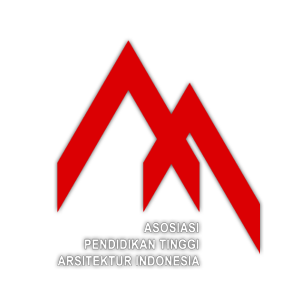Strategy for The Development of Sustainable Integrated Tourism Areas in Sedati District Sidoarjo
Muchlisiniyati Safeyah(1*), Wiwik Dwi Susanti(2), Fairuz Mutia(3)(1) Prodi Arsitektur, Fakultas Arsitektur dan Desain, Universitas Pembangunan Nasional “Veteran” Jawa Timur
(2) Prodi Arsitektur, Fakultas Arsitektur dan Desain, Universitas Pembangunan Nasional “Veteran” Jawa Timur
(3) Prodi Arsitektur, Fakultas Arsitektur dan Desain, Universitas Pembangunan Nasional “Veteran” Jawa Timur
(*) Corresponding Author
Abstract
The tourism village trend that is developing at this time is one of the important parameters in the development of Sedati District. Sedati District has some potential to be developed into a tourist village. The potential of tourist villages in Sedati District can be grouped into three types of tourist villages, namely coastal, arts and culture, and history. However, the diversity of tourism potential that is owned is not widely known by the wider community, has not been managed properly, and has not been integrated between one tourist village and another. The purpose of this study is to explore the potential and constraints of tourist villages in Sedati District so that strategies can be drawn up for the development of a sustainable integrated tourism area. The research is qualitative and quantitative, with a research approach using the positivism paradigm. The data analysis technique in this study used descriptive qualitative analysis and SWOT analysis. Sedati District has 8 villages that have the potential to be developed as integrated tourism villages. Have something to do, something to see, and something to buy. The weakness is that tourism objects are not visually attractive, do not involve the community, lack promotion, and there is no branding. The development strategy that can be carried out is to integrate and collaborate with the three existing types of tourism; create a regional arrangement design concept and visual quality according to the characteristics; integrate land conversion according to the RTRW; educate and prepare the community and village officials as tourism actors; synergize inter-village policies at the sub-district level; establish cooperation with the Navy, and the private sector; promote and strengthen branding with internet media; forming pokdarwis to realize the development of tourist villages
Keywords
Full Text:
PDFReferences
Arlini, W.P. (2003). Analisis Efektifitas Promosi Desa Wisata Candirejo Magelang. Jawa Tengah: Jurusan Usaha Perjalanan Wisata Sekolah Tinggi Pariwisata TRISAKTI.
Badan Pusat Statistik Kabupaten Sidoarjo. (2018). Kecamatan Sedati dalam Angka 2018. ©BPS Kabupaten Sidoarjo
Cohen, L., Manion, L., & Morrison, K. (2005). Research methods in education. British Library Cataloguing in Publication Data. Master e-book ISBN.
Darjosanjoto, E. T. S. (2006). Penelitian Arsitektur di Bidang Perumahan dan Permukiman. Surabaya: ITS Press.
David, F. (2009). Strategic Management: Manajemen Strategis Konsep. Jakarta: Salemba Empat.
Efendi, S. (2010). Analisa SWOT Sebagai Alat Perumusan Strategi
Groat, L., and Wang, D. (2002). Architectural Research Method. John Wiley Son, Inc.
Hadiwijoyo, Surya Sakti. (2012). Perencanaan Pariwisata Perdesaan Berbasis Masyarakat (Sebuah Pendekatan Konsep). Yogyakarta: Graha Ilmu.
Mieczkowski, Z.(1995). Environmental Issues of Tourism and Recreation. London: Univ.Press of America Inc.
Nawawi, H. (2012). Manajemen Strategik Organisasi Non Profit Bidang Pemerintahan. Yogyakarta: Gadjah Mada Press.
Nur, I., Mariantha, I. N., Syafri, Farida. (2018). Implikasi Pengembangan Desa Wisata Terhadap Peningkatan Ekonomi
Masyarakat Lokal (Studi Di Desa Pao). Prosiding Seminar Nasional dan Call for Paper. Manajemen, Akuntansi dan Perbankkan 2018, 1090-1104.
Nuryanti, W. (1993). Concept, Perspective and Challenges, makalah bagian dari Laporan Konferensi Internasional mengenai Pariwisata Budaya. Yogyakarta: Gadjah Mada University Press.
Permanasari, I. K. (2011). Pemberdayaan Masyarakat melalui Desa Wisata dalam Usaha Peningkatan Kesejahteraan. Jakarta: Tesis UI.
Putra, H.S.A. (2018). Pengembangan Desa Wisata untuk Kesejahteraan Masyarakat. Yogyakarta: Liputan Universitas Gajah Mada.
Rangkuti. (2013). Analisis SWOT Teknik Membedah Kasus Bisnis, Jakarta: Gramedia
Sugianto, A. (2016). Kajian Potensi Desa Wisata Sebagai Peningkatan Ekonomi Masyarakat Desa Karang Patihan Kecamatan Balong Ponorogo. Jurnal Ekuilibrium, Volume 11, Nomor 1, Maret 2016, 56-65.
Tahir, M. (2005). Pemanfaatan Ruang Kawasan Tepi Pantai Untuk Rekreasi Dalam Mendukung Kota Tanjungpinang Sebagai Waterfront City, Tesis Program Studi Magister Pembangunan Wilayah dan Kota. Semarang: Universitas Diponegoro.
Wahyuningsih, T. (2019). Pengembangan Desa Wisata Berkelanjutan Ditinjau dari Perspektif Wisatawan. Hotelier Journal Politeknik Indonusa Surakarta, Vol 5, No. 2, 65-79.n Par
Wattimena, R. A. (2017). Strategi Pengembangan Pesisir Pantai Desa Liang Sebagai Kawasan Objek Pariwisata, Jurnal Manis Volume 1 Nomor 1, 19-26. DOI: http://dx.doi.org/10.30598/manis.v1i1.153
Yoeti, O.A. (2008). Perencanaan dan Pengembangan Pariwisata. Jakarta:Pradnya Paramita
Article Metrics
Abstract view(s): 477 time(s)PDF: 413 time(s)
Refbacks
- There are currently no refbacks.









